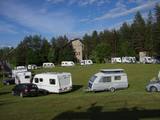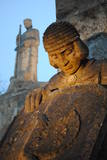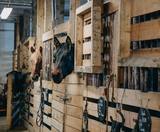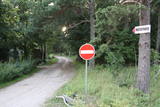| Nr | Nosaukums | Apraksts |
|---|---|---|
|
Līvānu kā lielākas apdzīvotas vietas pirmsākumi ir saistāmi ar 1533. g., kad toreizējais zemes īpašnieks Līvens izveidoja muižu un nosauca to savā vārdā par Līvenhofu. 1678. g. šeit tapa pirmā katoļu baznīca. Pilsēta būtiski cieta abu pasaules karu laikā. Līvānu vārds saistās ar stikla izstrādājumiem. 1887. g. šeit dibināja stikla fabriku, kas mūsdienās ir pārtraukusi savu darbību. |
||
|
Iespaidīga izmēra divstumbru liepa pie Nigliņu mājām. Viens no iespaidīgākajiem Lībiešu krasta dižkokiem. Lībiešu valodas skolotājas Zojas Sīles dzimtās mājas. Turpat pie mājām atrodas viduslaiku kapsēta – Veckapu kalns. |
||
|
Atrodas sporta un atpūtas kompleksā „Trīssaliņas”. No torņa paveras pievilcīga apkaimes ainava, kas īpaši skaista ir pieneņu ziedēšanas laikā. |
||
|
Piesta Kuusikaru saimniecība atrodas Vändra mežā, Pärnumaa. Ciemos tiek gaidīti visi, kuriem būs interesanti uzklausīt stāstu, kā šī ģimene uzsāka saimniekot laukos un nu ražo brīnumgardus produktus no āboliem. Saimniecībā var nogaršot visus produktus un to, kas iegaršojies, nopirkt līdzņemšanai. Šeit var arī lieliski atpūsties kopā ar ģimeni. |
||
|
Vasaras sezonā tiek piedāvāti braucieni ar plostu un laivām, nometnes bērniem, teritorija pasākumu organizēšanai, kempings nakšņošanai. Ziemas sezonā "Baiļos" atrodas slēpošanas centrs - kalnu slēpošanas trases, slēpošanas un snovborda inventāra noma, instruktoru pakalpojumi. Ēdināšanas piedāvājums kafejnīcā vai “Jurtā”. |
||
|
”Cīruļi” atrodas 5 km attālumā no Rūjienas, Jeru pagastā. Īpašums ir pārmantots no paaudzes paaudzē, īpašniekiem vienojoties kopīgā mīlestībā uz ziediem, dažādu augu audzēšanai pārvēršoties arī par vaļasprieku. Dārzā atrodamas arisēmas, ramondas, magnolijas, knifofijas, rodžersijas, ligularijas, rožainā radiola, ehinācijas un vēl daudz vairāk pazīstamu, skaistu augu. Pavasaris iesākas ar sniegarožu un daudzo sīpolpuķu plaukšanu, vēlāk - krāsainie īrisu ziedi un trauslās astilbju skaras. Daudz skaistuma un krāsainības puķu dobēm piedod heihēras un hostas, kas priecē līdz pat vēlam rudenim. Dārzā aug arī skujeņi, vīteņaugi un katru gadu ražojoši vīnogulāji, kas veido pašu dārza telpu.
|
||
|
Brāļu kapos apbedīti aptuveni 2000 karavīru. Pirmos kritušos strēlniekus — Andreju Stūri, Jēkabu Voldemāru Timmu un Jāni Gavenasu — apbedīja 1915. gada 15. oktobrī. Sākot ar 1915. gadu, kapos sāka apbedīt Pirmā pasaules kara kaujās kritušos strēlniekus, vēlāk Februāra revolūcijas laikā nošautos kareivjus. Stučkas valdības laikā 1919. gada pavasarī šeit apbedīja Brīvības cīņās pret vācu vienībām un Dienvidlatvijas brigādi kritušos latviešu strēlniekus. Pirmās Latvijas brīvvalsts laikā Brāļu kapos apbedīja ap 800 Latvijas armijas kareivjus un virsniekus. 1941.—1942. gadā Brāļu kapos apbedīja 15 nacionālos partizānus, kā arī pārapbedīja komunistiskā režīma terora upurus. Līdz 1944. rudenim šeit apbedīja arī vairākus desmitus bijušās Latvijas armijas virsnieku un karavīru, kuri bija dienējuši Latviešu policijas bataljonos un Latviešu leģionā. Abās pusēs ieejas vārtiem (augstums 10 metri, platums 32 metri) divas jātnieku skulptūru grupas (augstums 3,3 metri). Liepu gatve (205 metri) savieno vārtus ar galveno terasi, kuras centrā novietots 1 metru augsts mūžīgās uguns altāris, bet abās pusēs ozolu birzis. No terases abpusējas kāpnes ved uz regulāri veidotu kapulauku. Tā malās atrodas divas "Mirstošo jātnieku" skulpturālās grupas (augstums 3,6 metri), vidus daļā atrodas augstcilnis "Kritušie brāļi". Pret katru kapa vietu novietota smilšakmens vai plienakmens plāksnīte ar kritušā uzvārdu un vārdu vai uzrakstu "Nezināms". Ansambli noslēdz 6 metrus augsta siena ar Latvijas apriņķu un pilsētu vēsturiskajiem ģerboņiem. Pie sienas atrodas četri senlatviešu karavīru tēli, kas simbolizē Latvijas novadus - Kurzemi, Zemgali, Vidzemi un Latgali, bet tās centrā uz 9 metrus augsta sienas masīva paceļas monumentāla figūra "Māte Latvija", kas noliekusi vainagu pār kritušajiem dēliem. Brāļu kapu memoriālais ansamblis ir izcirsts no Allažu šūnakmens, izmantots arī Itālijas travertīns un smilšakmens. Pirmmetu izstrādāja tēlnieks Kārlis Zāle, arhitekts Aleksandrs Birzenieks, Pēteris Feders un Andrejs Zeidaks. |
||
|
Vidzemē, Valmiermuižā, 19.gs. celtā ēku kompleksā, ko iekļauj mūra žogs, atrodas Valmiermuižas stallis un Valmiermuižas jātnieku skola. Tajā saimnieko Jurašu ģimene - zirgkopju, zirgu selekcionāru un vetārstu ģimene daudzās paaudzēs. Ir iespēja doties izjādēs, ekskursijās, kā arī tiek rīkotas radošās nometnes bērniem. |
||
|
Saimniecība atrodas ainaviskā vietā starp Rīgas-Ventspils (A-10) autoceļu un Tukumu, kuras apkaimē vērojama skaista un pauguraina ainava. Pauguru dienvidu nogāzēs plešas vīnogu lauki, kuros tiek audzētas ~ 60 dažādu vīnogu šķirnes. Apmeklētājiem te piedāvās ekskursijas pa dārzu ar mirkli atpūtai uz terases ar īpašo saimnieces cienastu. Te var iegādāties arī vīnogas un pasūtīt tās iepriekš. Otra saimniecības specializācija ir aitu audzēšana. Interesenti var apskatīt ganāmpulku, kā arī, iepriekš vienojoties, iegādāties jēra gaļu. Saimniece Gunta Niedra labprāt dalās pieredzē un konsultē tos, kas uzsāk aitu audzēšanas rūpalu. Piemērotākais saimniecības apmeklējuma laiks ir no maija līdz novembrim, kad ir patīkami uzturēties ārpus telpām. |
||
|
Atrodas Cenas tīreļa dabas takas sākumā. No tā labi pārskatāma kūdrā izstrādātā Cenas tīreļa neliela daļa. |
||
|
Saimnieki ražo žāvētu garšaugu maisījumus un vitamīnu tējas pilnā ciklā – no sēklas līdz garšvielu paciņai. Saimniecības dobēs un siltumnīcās aug plašs dārzeņu un garšaugu klāsts - dilles, sīpoli, ķiploki, maurloki, piparmētras, salvija, timiāns, koriandrs, izops, estragons, pupumētra, čili, baziliks. Izmanto arī savvaļas augus - nātres, gārsas, vībotnes, pienenes, pelašķus, raudenes. |
||
|
Tikai 20 minūšu braucienā no Pärnu, vecajā Tõstamaa mežniecības ēkā Amps & Lonks kafejnīca ceļiniekiem piedāvā nedaudz atpūsties un iestiprināties ar picu, kas gatavota no svaigiem vietējiem produktiem. Īpaši iecienīta ir pica ar pašaudzēto liellopu gaļu un svaigie salāti. Var arī pasūtīt iepriekš. |
||
|
No Rīgas maršruts ved uz kazu saimniecību, kur iespējams apskatīt dzīvniekus un nogaršot sierus. Tad apmeklējiet Mālpils muižu un nobaudiet vietējos sierus, kas pagatavoti no govs piena. Tālāk maršruts ved Daugavas virzienā uz Skrīveriem, kur iespējams nogaršot mājās gatavotu saldējumu un tradicionālās Skrīveru "Gotiņas". Pēc tam apmeklējiet leģendārās Kokneses pilsdrupas. Tālāk - etnogrāfiska lauku sēta gleznainā Jaunpiebalgas apkārtnē un siera un mājas makaronu ražotne Raunā. Cēsu vecpilsētas un viduslaiku Livonijas ordeņa pils apskate. Maršruts ved tālāk līdz kaņepju saimniecībai, kur iespējams nogaršot tradicionālā veidā pagatavotus kaņepju produktus. Pēc tam dodieties uz Rūjienas saldējuma fabriku un bijušajām dzirnavām, kur senatnīgās vilnas apstrādes iekārtas vēl joprojām tiek izmantotas un ir iespējams tās aplūkot. Dodoties atpakaļ Rīgas virzienā, maršruts aizved līdz jūras piekrastei, kur iespējams apmeklēt Minhauzena muzeju un klausīties neticamajos Minhauzena stāstos. Apciemojiet nēģu zvejniekus un dodieties pastaigā gar smilšaino jūras pludmali. |
||
|
35 m plats un 0,5m augsts Abavas upes ūdenskritums. Blakus labiekārtota teritorija ar teltsvietām, šūpolēm, piknika un ugunskura vietām. Iespējams apmeklēt visu gadu. Netālu Sabiles vīna kalns, Pedvāles Brīvdabas māksas muzejs, trulīšu nobrauktuve "Sventes dzirnavas" un citas apmeklēšanas vērtas vietas.
|
||
|
Kafejnīca Ugandi ir mājīga vieta pašā Otepää sirdī, kur valda silta gaisotne, patīkamas noskaņas un garšas ir tīras un tīkamas. Ierodoties tūliņ sajutīsiet kvalitatīvas kafijas un saldu maizīšu smaržu. Lielā vitrīna ir pilna gardām kūkām – tās var baudīt gan uz vietas, gan iegādāties līdzņemšanai. |
||
|
Meklējama Dvietes - Bebrenes ceļa malā. Atjaunotā ēka celta 1874. gadā. Pēc 1. pasaules kara klēti līdz 1929. g. izmantoja kā lūgšanu telpu, līdz atjaunoja Dvietes katoļu baznīcu. |
||
|
Muiža vēsturiskajos dokumentos pirmoreiz ir pieminēta 16. gs. Tagad redzamā vienstāva kungu māja ir vairākreiz pārbūvēta laikā no 17. – 19. gs. 1997. g. ēku vēlreiz atjaunoja un tagad tajā atrodas viesu nams un Vilsandi nacionālā parka apmeklētāju centrs, kur var iegūt ne tikai vērtīgu informāciju, bet arī apskatīt Vilsandi apkārtnē atrastās fosilijas. No Lonas muižas var uzsākt pārgājienu uz Vilsandi salu. Vienā no muižas ēkām ir izveidota Vilsandi nacionālajam parkam veltīta ekspozīcija. |
||
|
Bistro "Bērzkrogs" atrodas 130 m no Bērzkroga krustojuma (iepretim Statoil DUS). Atbalsta sadarbību ar vietējiem ražotājiem, kuru produkti ir nobaudāmi vai nopērkami (arī suvenīri) uz vietas. Latviešu virtuve: Pelēkie zirņi ar speķi, putraimu biezputra. |
||
|
Atrodas 0,3 km ziemeļos no Vecpiebalgas pilsdrupām. Ap 10 m augsto, bet visnotaļ izteiksmīgo Grišku kalnu sauc arī par Piebalgas, Balgas un Veļķu pilskalnu. 13. gs. šeit bijusi svarīga apmetnes vieta ar mākslīgi nostāvinātām nogāzēm un dziļu aizsarggrāvi. Vēstures notikumi ir atstājuši ap metru biezu kultūrslāni. Bezlapu laikā no kalna paveras skats uz Vecpiebalgas baznīcu un pilsdrupu vietu. Pilskalna piekājē ir aka ar Griškavotu. |
||
|
Bijušā Jūrkalnes Padomju pretgaisa aizsardzības diviziona daļa šobrīd atrodas privātīpašumā un tur izveidota mototrase.
|
||


























